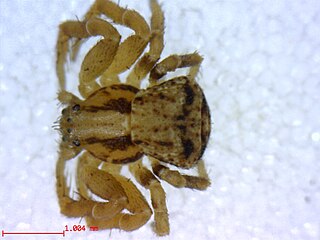
Atypidae, also known as atypical tarantulas or purseweb spiders, is a spider family containing only three genera. They are accomplished ambush predators that spend most of their time in a sock-like, silken retreat on the ground from where they kill their prey.

Crevice weaver spiders (Filistatidae) comprise cribellate spiders with features that have been regarded as "primitive" for araneomorph spiders. They are weavers of funnel or tube webs. The family contains 18 genera and more than 120 described species worldwide.

Chlorophytum comosum, usually called spider plant or common spider plant due to its spider-like look, also known as spider ivy, ribbon plant, and hen and chickens is a species of evergreen perennial flowering plant of the family Asparagaceae. It is native to tropical and Southern Africa but has become naturalized in other parts of the world, including Western Australia and Bangladesh. Chlorophytum comosum is easy to grow as a houseplant because of its resilience, but it can be sensitive to the fluoride in tap water, which commonly gives it "burnt tips". Variegated forms are the most popular.
Ozyptila is a genus of crab spiders that was first described by Eugène Louis Simon in 1864. It has been misspelled as "Oxyptila" in multiple accounts.
Ozyptila bejarana is a species of crab spiders found in Spain and France.
Ozyptila danubiana is a species of crab spiders found in Romania and Greece.
Ozyptila flava is a crab spider species found in Spain. It is one of a number of species first described by Eugène Simon that do not appear to have been studied since.
Ozyptila maculosa is a crab spider species found in England.
Ozyptila nigristerna is a crab spider species found in Italy.
Ozyptila perplexa is a crab spider species found in Spain, France, and Algeria.
Ozyptila salustri is a crab spider species found in Tuscany, Italy.
Ozyptila is a crab spider species found in Switzerland and Italy.

Ozyptila trux, the yellow leaflitter crab spider, is a crab spider species with Palearctic distribution.
Ozyptila umbraculorum is a crab spider species found in Portugal, Spain and France.
Ozyptila gertschi is a crab spider species with Holarctic distribution. It is considered new to the fauna of Latvia since 2009.

Ozyptila pacifica is a species of crab spider in the family Thomisidae. It is found in the United States and Canada.

Ozyptila sincera is a species of crab spider in the family Thomisidae. It is found in Russia, Korea, and Japan.

Ozyptila distans is a species of crab spider in the family Thomisidae. It is found in the United States and Canada. It can commonly be found on coniferous logs.
Ozyptila monroensis is a species of crab spider in the family Thomisidae. It is found in the United States and Canada.






